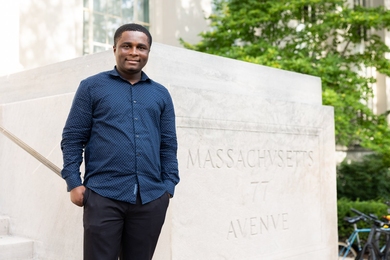This is the first in an occasional series of conversations with MIT art-makers.
When not working with Professors Tom Leighton and Bonnie Berger in her job as administrative secretary in the Laboratory for Computer Science, Susan Welby is an acoustic rock guitarist, singer and songwriter. Her debut CD, "heaven & water," (Road Songs Records) was released in December 1997. Describing the disk as "an acoustic collection of easy listening tunes and beautifully harmonized vocals," reviewer Alex Scheibe said that the first song was a "definite standout, but the real standout on this CD is Susan Welby herself."
Ms. Welby has performed at the Cambridgeport Open Artist Studios, the Middle East, Cafe Soho, Kendall Cafe, for Boston's Art in the Heart of Boston series, Harvard University's Arts First festival and at Faneuil Hall. She also led a jazz quintet at Somerville's Willow Jazz club for 10 years before they closed last year.
On Wednesday, Oct. 28, Ms. Welby will perform at the BMI Acoustic Roundup in New York City, and on November 11 she'll be the featured songwriter with the Bad Moon Rising band at the Burren (Davis Sq, 247 Elm St., Somerville). She's also currently assisting producer David Doms with a film score for Gamblers, an independent film drama. Lynn Heinemann of the Office of the Arts asked Ms. Welby about her non-MIT career.
Heinemann: How did you get started?
Welby: I've been singing, playing guitar and composing since I was 14 years old, teaching myself guitar and songwriting. A friend of mine heard me playing once and asked me to join his rock band. So I performed in Milwaukee -- I grew up in a nearby suburb in Wisconsin -- with his band. I later went to Berklee College of Music in Boston for a few semesters and along the way had lessons in vocal technique from some great teachers. I've also taught singing, songwriting and guitar privately.
Heinemann: Who are your role models?
Welby: Rickie Lee Jones for her great arranging and conversational singing style. Joni Mitchell for her lyrical style and experimentation with open guitar tunings. Kate Bush for her drama. And jazz singers Billie Holiday for her sweet honesty and Abbey Lincoln for her tonal experimentation.
Heinemann: How do you get your inspiration for songs?
Welby: Mostly by listening closely to people when they're talking about something they really care about and from rock bands, symphonies, poetry, walks by the ocean and in our beautiful city, Boston.
Once I find a strong melody, I support it with a contrasting harmony and rhythm. Lyrics evolve from a phrase that's spinning around in my head. The song story builds from a mood or emotion that I'm feeling. The art and purpose of songwriting is to articulate emotion in words.
Heinemann: Tell me about your CD.
Welby: I sang all the female harmony parts on my CD. We all had such a good time, we went to lunch together afterwards. [laughs]
But seriously, I wrote all nine songs and did all of the instrumental and vocal arrangements. I invited some great musicians from the Boston area who had performed in my quintet at the Willow Jazz Club. There was one singer on my CD who I heard performing in Harvard Square. He had the perfect tenor voice for my song "Begin to Feel," so I asked him if he would come to the studio that night and sing the harmony. It turned out that he was visiting from Florida. He was great and fun to work with on the spot like that.
I thought that the song "Radiating Tears" would be the title of my CD but I decided that the name sounded too sad so I chose "heaven & water" instead. It's not a religious song but it uses the words heaven and water as a metaphor to represent two things that are close but never quite meet.
Heinemann: How do you balance your music and your job at MIT?
Welby: Fortunately, I'm surrounded by computers and computer scientists in my job at the Lab for Computer Science. Computer scientists and musicians both use forms developed first from our imaginations. The fine details sculpted from these forms are what creates the magic in the final products of their fields.
My job environment is inspiring to me musically and socially. I spend just about all of my time away from the office on creative and business plans for my music. It's a wonderful mix for me.
A version of this article appeared in MIT Tech Talk on October 21, 1998.





